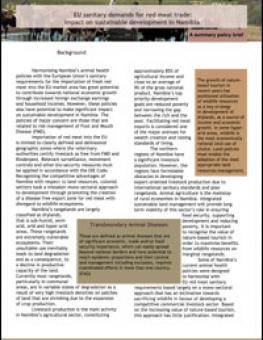
RTEA Namibia Sectoral Paper - EU Sanitary Demands for Red Meat Trade: Impact on Sustainable Development in Namibia
Namibia has recently undertaken a rapid trade and environment assessment, which identified potential green opportunities and likely threats from international trade law and technical standards. The assessment has ignited national debate among stakeholders from the often unconnected sectors of international trade, environment, agriculture, water, energy, tourism and others. The rapid assessment is the start of a process of greater collaboration between these previously distinct sectors, which will have the opportunity to collaborate to a greater extent in the future. Namibia's economy cannot compete with neighbouring South Africa's economic and infrastructural advantages, but the country can excel in some high-value niche areas, depending on how policy-makers plan ahead.
Harmonizing Namibia's animal health policies with the European Union's sanitary requirements for importation of fresh red meat into the EU market has great potential to contribute to national economic growth through increased foreign exchange earnings and household incomes. This policy brief highlights opportunities and areas for further attention and follow-up in the red meat sector.
Key findings:
-
Livestock production is the main activity in Namibia's agricultural sector, constituting approximately 85% of agricultural income and, on average, close to 9% of GNP.
-
Facilitation of red meat exports is considered one of the major avenues for creating wealth and raising standards of living.
-
Importation of red meat into the European Union is limited to clearly defined and delineated geographic zones where the veterinary authorities certify livestock as free from foot-and-mouth disease and rinderpest.
-
Regulations developed for the EU countries' agricultural industry are not necessarily best-suited or relevant to a drylands, rural, African development context.
Key recommendations:
-
Namibia needs close integration of land-use planning, conservation efforts and animal health policies related to foot-and-mouth-disease control in order to maximize the benefits from diverse land-use systems.
-
Policies and strategies to promote red meat exports must not fixate on creating disease-free zones in a manner that sacrifices other livelihoods that are based on utilization of wildlife resources.
-
Due to high competition for low-productivity rangelands in the northern regions, utilization of transboundary grazing resources may continue to be one of the main strategies for sustaining livestock densities in these areas for the foreseeable future. As a consequence, Angola and Namibia must consider developing a transboundary animal disease risk-management zone straddling the border between the two countries.
-
Efforts to broaden marketing opportunities for livestock farmers in the northern regions by harmonizing sanitary measures with the import requirements of lucrative red meat export markets including the European Union must not be limited to animal health.
-
Management of the interface between livestock and wildlife must be guided by risk assessments based on sound science.
-
Namibia, singly or as part of the regional bloc, should actively participate in the formulation of international animal health standards, particularly those related to international trade in fresh and frozen meat.
You might also be interested in
Will the Inclusion of Voluntary Standards in Trade Agreements Lead to More Sustainable Trade?
The use of voluntary sustainability standards (VSSs) and similar systems in free trade agreements (FTAs) is gaining traction. Will it lead to more sustainable production and consumption globally?
Strategic Environmental Assessment for the Mining Sector
Strategic environmental assessments (SEA) are an essential tool for policy-makers working to develop a sector-wide vision for responsible mining.
Blackouts and Backsliding: Energy subsidies in South Africa 2023
Blackouts and Backsliding presents the latest energy subsidy data for South Africa.
Sustainable Asset Valuation of Parques del Río Norte in Medellín, Colombia
This economic valuation demonstrates the benefits of expanding urban green space in the city of Medellín, Colombia.